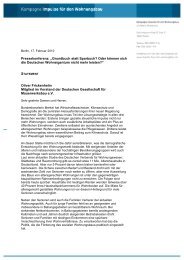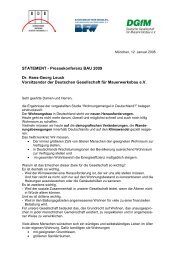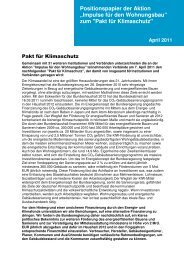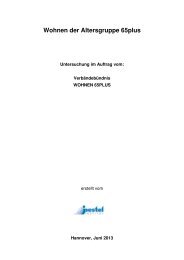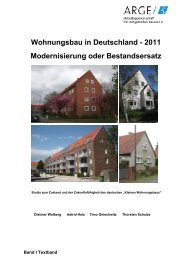BFW-Studie - European Union of Developers and House Builders
BFW-Studie - European Union of Developers and House Builders
BFW-Studie - European Union of Developers and House Builders
You also want an ePaper? Increase the reach of your titles
YUMPU automatically turns print PDFs into web optimized ePapers that Google loves.
<strong>BFW</strong>-Study<br />
Introduction<br />
Adaptation <strong>of</strong> the housing stock to suit<br />
senior citizens<br />
The Federal Republic <strong>of</strong> Germany is getting older. According to research by the Federal<br />
Statistics Office around 25 percent <strong>of</strong> Germans will be older than 65 in 2020. In 2050 a<br />
third <strong>of</strong> the German population will be over 65. Eleven percent <strong>of</strong> Germans will then be<br />
80 or older <strong>and</strong> thus belong to the very elderly category, for whom there is a 30 percent<br />
risk <strong>of</strong> requiring nursing care.<br />
More than three quarters <strong>of</strong> citizens requiring nursing care are still cared for in their<br />
domestic surroundings <strong>and</strong> approximately 90 percent are cared for by family networks.<br />
Decreasing birth rates, traditional family structures increasingly breaking up as well as a<br />
declining willingness by people, especially women, to defer pr<strong>of</strong>essional prospects for<br />
nursing activities, are reducing this domestic nursing potential more <strong>and</strong> more.<br />
From the viewpoint <strong>of</strong> the German development business the target groups for rented accommodation<br />
<strong>and</strong> home ownership are increasingly changing around. Development<br />
companies in Germany have thus realised that older consumers are becoming an ever<br />
more important target group, to whose individual needs <strong>and</strong> market expectations the<br />
German <strong>and</strong> also the Pan-<strong>European</strong> sector must adjust.<br />
Against this background the Federal Republic <strong>of</strong> Germany has reacted to the demographic<br />
changes <strong>and</strong> associated impact on the property markets. The housing policy adopted<br />
by the German Federal Government as well as German States is increasingly becoming<br />
oriented to the needs <strong>of</strong> the elderly <strong>and</strong> people requiring nursing care. The consequenses<br />
are an altered subsidy policy, <strong>and</strong> also stronger legal regulations within this market<br />
sector.<br />
In view <strong>of</strong> the demographic change <strong>and</strong> the associated alterations, which are not only restricted<br />
to Germany, but also affect broad sections <strong>of</strong> Europe, Bundesverb<strong>and</strong> Freier Immobilien-<br />
<strong>and</strong> Wohnungsunternehmen [German Federation <strong>of</strong> Independent Property<br />
<strong>and</strong> Housing Companies] (<strong>BFW</strong>) as a member <strong>of</strong> the <strong>European</strong> <strong>Union</strong> <strong>of</strong> <strong>Developers</strong> <strong>and</strong><br />
<strong>House</strong> <strong>Builders</strong> (UEPC) has compiled a study on the housing <strong>and</strong> care models catering for<br />
the elderly market sector. The 13 member federations * <strong>of</strong> the UEPC represent approximately<br />
30,000 housing <strong>and</strong> building companies in Europe, which account for more than ten<br />
percent <strong>of</strong> the <strong>European</strong> gross national product. In total they build <strong>and</strong> develop<br />
1,000,000 new homes <strong>and</strong> several million m 2 <strong>of</strong> commercial space <strong>and</strong> shopping centres<br />
per year.<br />
The proportion <strong>of</strong> the housing stock catering to the needs <strong>of</strong> the elderly in <strong>European</strong><br />
countries is only one percent <strong>of</strong> all homes on average. This figure is already around<br />
*<br />
This study presents survey results from UEPC [<strong>European</strong> <strong>Union</strong> <strong>of</strong> <strong>Developers</strong> <strong>and</strong> <strong>House</strong> <strong>Builders</strong>] members Austria,<br />
Belgium, France, Germany, Great Britain, Irel<strong>and</strong>, Italy, the Netherl<strong>and</strong>s, Pol<strong>and</strong>, Portugal, Romania, Spain<br />
<strong>and</strong> Turkey as well as from Finl<strong>and</strong>, Latvia <strong>and</strong> Sweden. The evaluation results are supplemented by those from<br />
other Eastern <strong>and</strong> Central <strong>European</strong> countries in the second stage.<br />
20 <strong>BFW</strong>-Study 2007




